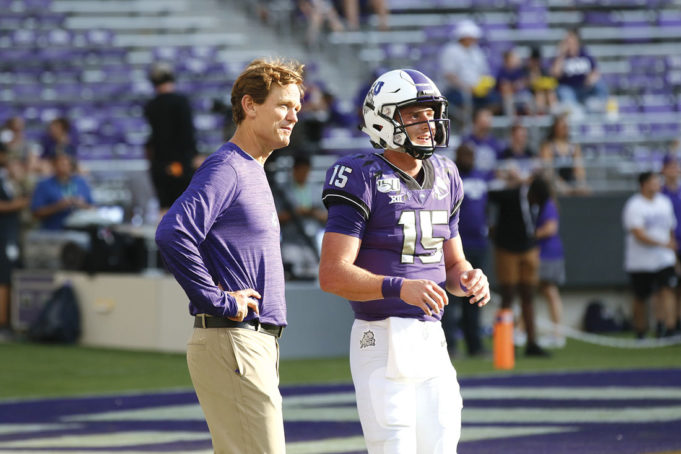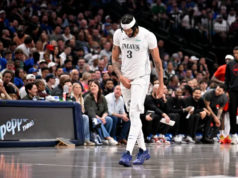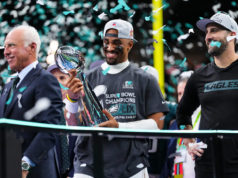Bye weeks are an opportunity for outrospection. Frog fanatics were likely glued to their televisions or mobile devices trying to digest the contents and outcomes of Texas-OU and Texas Tech at Baylor. Neither match-up provided solace for the prospect of mid- or late-season runs from our Frogleteers. The Sooners are predictably a touchdown better than the Longhorns, and Baylor’s refs boosted the Bears past late-game foibles to best the Raiders in double overtime. The most prominent takeaway from watching last weekend’s Big 12 action is improved balance among our conference rivals. While overpowered offenses are a mainstay, defenses around the state of Texas and their neighbors have improved. What does this mean for the Frogs? Average offense yields an average result and fighting for bowl eligibility late in the season.
Defensive Derivatives
I’m no mathematician, nor a statistician, but basic statistical trends exist for Coach Gary Patterson’s team. TCU’s defense is consistently respectable or better. The Horned Frog stoppers, on average, haven’t allowed more than 28 points per game since joining the conference in 2012. In that season, Patterson’s unit lost seven games. In 2014 and 2017, opponents accumulated only 19 points per game –– stingy enough to elevate the Froggies to 12 and 11 wins, respectively. Linebacker Garrett Wallow (No. 30) and friends are surrendering slightly fewer than 25 points per game thus far, a seemingly benign figure that becomes frightening considering their back-loaded schedule. Arkansas Pine Bluff and Kansas should be skewing that stat in a more favorable direction at this time in the season.
Cumbie Calculus
Offensive Coordinator Sonny Cumbie faces widespread criticism stemming largely from the lack of offensive output last season. Whether or not that’s fair is irrelevant. The expectation in major college football is to win or find a new job. For fun, let’s look at the progression since TCU matriculated into a big-boy conference. The Froggers’ arrival began with forgettable seasons in 2012 and 2013, the latter Patterson’s worst record during his tenure in Fort Worth at 4-8. The next year was –– in my not so humble opinion –– an even greater accomplishment than the Rose Bowl victory in 2011. Cumbie, with the help of quarterback Trevone Boykin and receiver Josh Doctson, saw his offense blow past everybody, improving TCU’s average offensive output by three touchdowns per game from the 2013 season. Their 12-1 record represents the best statistical performance by both offense and defense in one season. Patterson’s defense declined starkly in 2015, allowing nine more points per game than the previous season. The offense dipped to 42 points per game, still ample firepower to achieve an 11-2 record. Boykin and Doctson departed the next year for the NFL, leaving a void where their impressive scoring average had been. Cumbie’s offense declined 11 points a game with transfer and now-coach Kenny Hill debuting in the quarterback spot, which corresponded with the defense’s worst performance to date and a losing record of 6-7. The narrative flipped in 2017 during Hill’s senior season. The offense didn’t improve overwhelmingly –– 2.6 points-per-game better –– but Patterson’s unit shut down the competition to match their 2014 performance and welcome back double-digit wins. I shudder to mention the 2018 season, when the purple offense plummeted to a 20-year production low. Patterson’s defense was average, and TCU outscored their opponents by a razor-thin four-tenths of a point per game on the season. Their bowl eligibility last year should be considered a master chef’s version of crafting chicken salad out of … ya know.
Find the Variable
This won’t be a magical season. The commonalities between the Frogs’ successful seasons rest squarely with the man handling the snaps. Boykin’s early years –– spent splitting snaps with the in-and-out-of-rehab Casey Paschall –– were atrocious by the numbers. Hill’s first year in purple was also underwhelming despite the wealth of game experience he brought to campus. Most signal callers need multiple years on the field in one system to elevate their games to meet the daunting expectations of football fanatics. Patterson and Cumbie achieved symbiotic success in 2014 and 2017. Boykin and Doctson managed to tow their depleted defense to success in 2015 also. Freshman quarterback Max Duggan (No. 15) is improving already. He needs a year or possibly two to transform into the passer who will boost Cumbie’s offense to its former glory. There are no guarantees the coordinator will last long enough to experience it. The purple offense is averaging 37 points per game this season. Numbers tell all types of stories. Currently, they’re tattling on Patterson’s defense. TCU travels to Kansas State for an early afternoon kickoff on Saturday to face the Jekyll-and-Hyde Wildcat squad. This might represent the most winnable game left on the Frogs’ schedule, save for West Virginia. TCU alums should feel safe planning Christmas ski trips if Patterson’s boys don’t leave victorious. l











